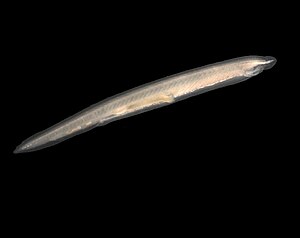Skullless
| Skullless | ||||||||||||
|---|---|---|---|---|---|---|---|---|---|---|---|---|

Recent lancetfish ( Branchiostoma lanceolatum ) |
||||||||||||
| Temporal occurrence | ||||||||||||
| Cambrian (late Terreneuvian ) until today | ||||||||||||
| 525 to 0 million years | ||||||||||||
| Systematics | ||||||||||||
|
||||||||||||
| Scientific name | ||||||||||||
| Cephalochordata | ||||||||||||
| Owen , 1846 |
The acrania (Cephalochordata ( Gr . "Head chordates"), Syn . Acrania (of . Altgr Ακράνια .: "cephalochordate")) are a sub-tribe of the chordates . The Acranians were an extraordinarily successful group in fossils , today these chordates are only represented by three genera of the lancet fish (Amphioxiformes).
features

The animals are slender, fish-like in shape and taper on both sides. A bony skull , a real brain , a spine and extremities are missing. At the mouth opening they have mouth cirrus , which protect the mouth opening.
Skullless ones have characteristic features ( apomorphies ) that identify them as chordates, including the notochord , a dorsal neural tube and a muscular postanal tail . They have an appendix , which is believed to be homologous to the liver of vertebrates.
Systematics
The skullless are probably the closest relatives of the vertebrates (Vertebrata), which are also known as skull animals (Craniota or Craniata) ( Notochordata-Urochordata hypothesis ). Another hypothesis, however, places the skullless animals more fundamentally and sees the tunicates as the closest relatives of the vertebrates ( Olfactores-Cephalochordata hypothesis ).
Skullless in the fossil record
The bodies of skullless people are seldom preserved due to the lack of cartilaginous or bony hard parts, so their development history is only documented by poor or dubious fossil finds . Probably the oldest known form is Pikaia from the middle Cambrian about 530 million years ago from the Canadian Burgess slate known for its extraordinary soft tissue preservation .
The fossil best known skullless are the conodonts , which are important as reference fossils, with more than 3000 described species. Their exact systematic position is not clear, however, many processors place them in relation to the vertebrates.
Web links
proof
Footnotes directly behind a statement cover the individual statement, footnotes directly behind a punctuation mark the entire preceding sentence. Footnotes after a space refer to the entire preceding text.
- ↑ a b c Thomas Günther Stach: Cephalochordata In: Michael Hutchins, Dennis A. Thoney, Neil Schlager (Eds.): Grzimek's Animal Life Encyclopedia - Second Edition - Volume 1 - Lower Metazoans and Lesser Deuterostomes , 2003, pp. 485-493 , ISBN 0787653624
- ^ Walter C. Sweet, Philip Donoghue: Conodonts: Past, present, future , In: Journal of Paleontology, 2001, 75: 6, pp. 1174-1184, online